Abstract
OBJECTIVE: To assess the effects of payment methods on the costs of care in medical group practices. DATA SOURCES: Eighty-six clinics providing services for a Blue Cross managed care program during 1995. The clinics were analyzed to determine the relationship between payment methods and cost of care. Cost and patient data were obtained from Blue Cross records, and medical group practice clinic data were obtained by a survey of those organizations. STUDY DESIGN: The effects of clinic and physician payment methods on per member per year (PMPY) adjusted patient costs are evaluated using a two-stage regression model. Patient costs are adjusted for differences in payment schedules; patient age, gender, and ACG; clinic organizational variables are included as explanatory variables. DATA COLLECTION: Patient cost data were extracted from Blue Cross claims files, and patient and physician data from their enrollee and provider data banks. Medical group practice data were obtained by a mailed survey with telephone follow-up. PRINCIPAL FINDINGS: Capitation payment is correlated with lower patient care costs. When combined with fee-for-service with withhold provisions, this effect is smaller indicating that these two clinic payment methods are not interchangeable. Clinics with more physician compensation based on measures of resource use or based on some share of the net revenue of the clinic have lower patient care costs than those with more compensation related to productivity or based on salary. Salary compensation is strongly associated with higher costs. The use of physician profiles and clinical guidelines is associated with lower costs, but referral management systems have no such effect. The lower cost clinics are the smaller, multispecialty clinics. CONCLUSIONS: This study indicates that payment methods at both the medical group practice and physician levels influence the cost of care. However, the methods by which that influence is manifest is not clear. Although the organizational structure of clinics and their use of managed care programs appear to play a role, this influence is less than expected.
Full text
PDF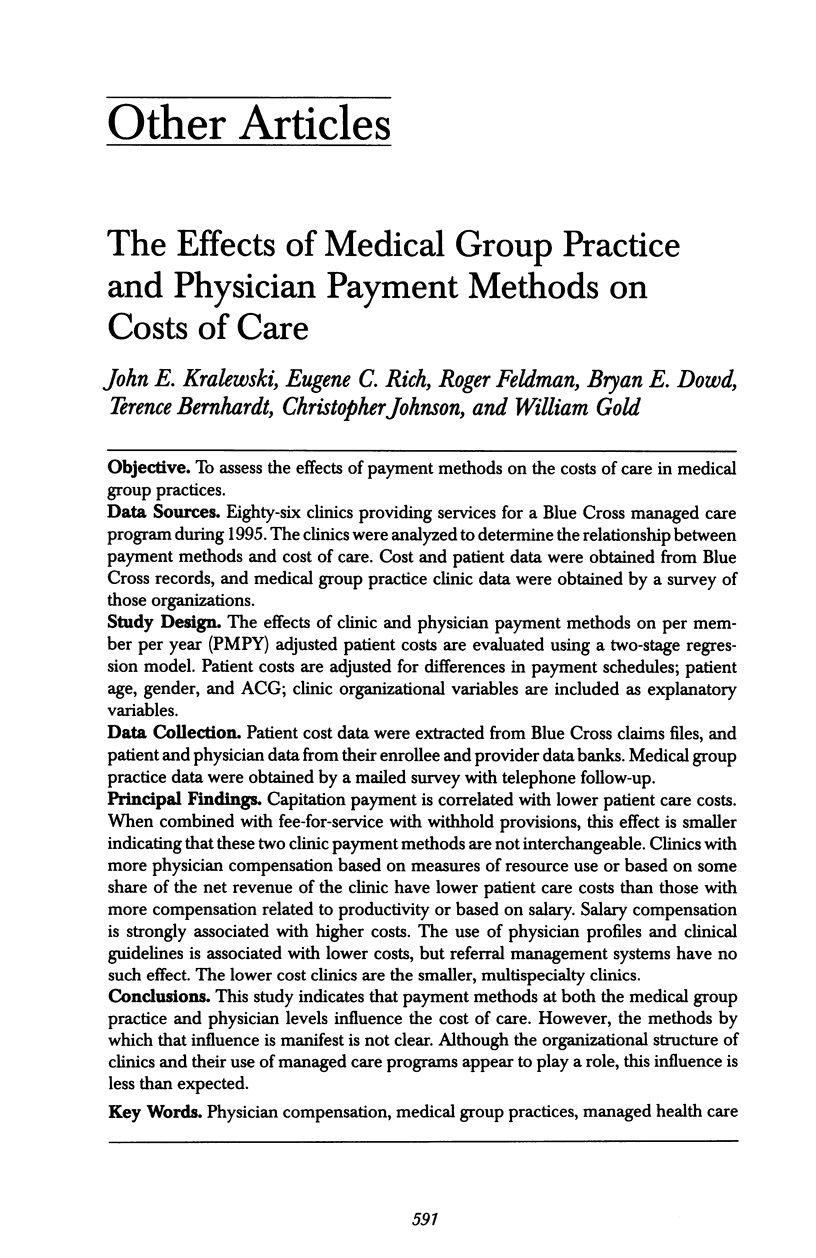
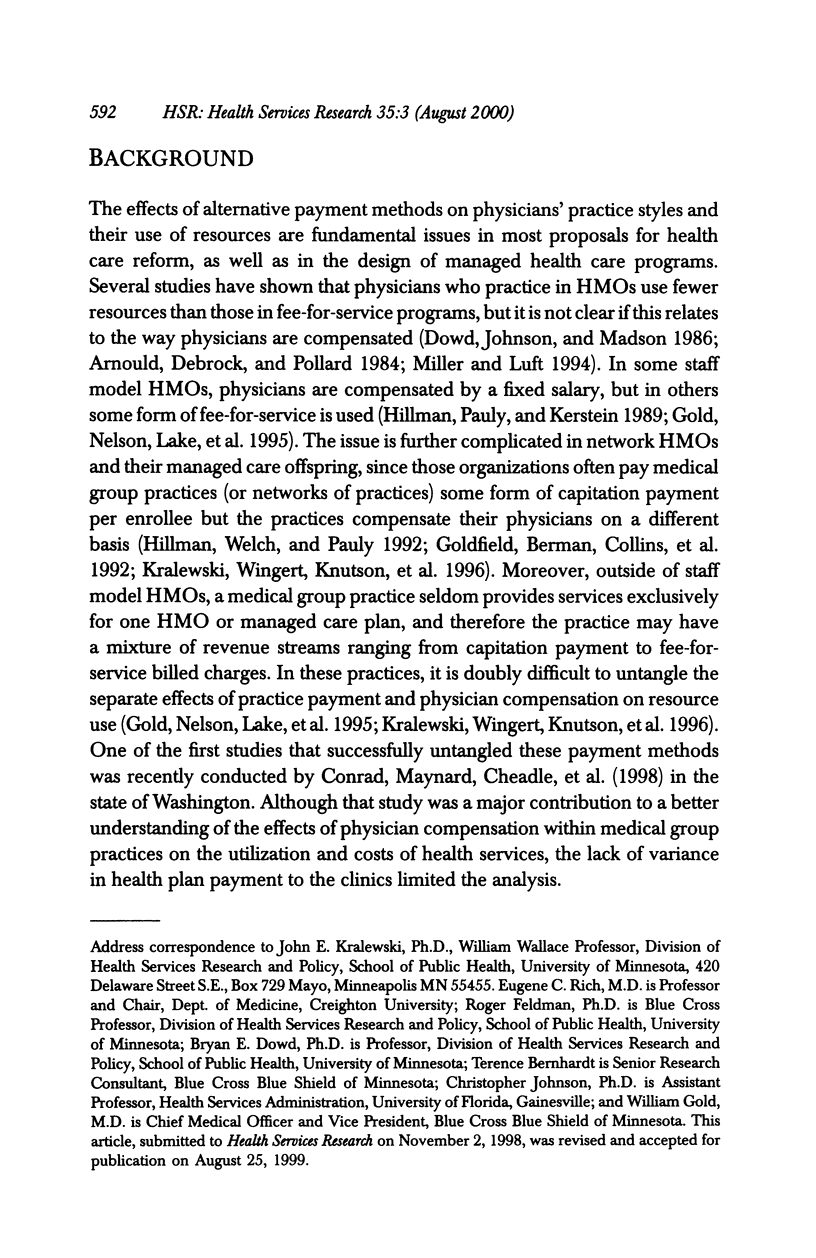
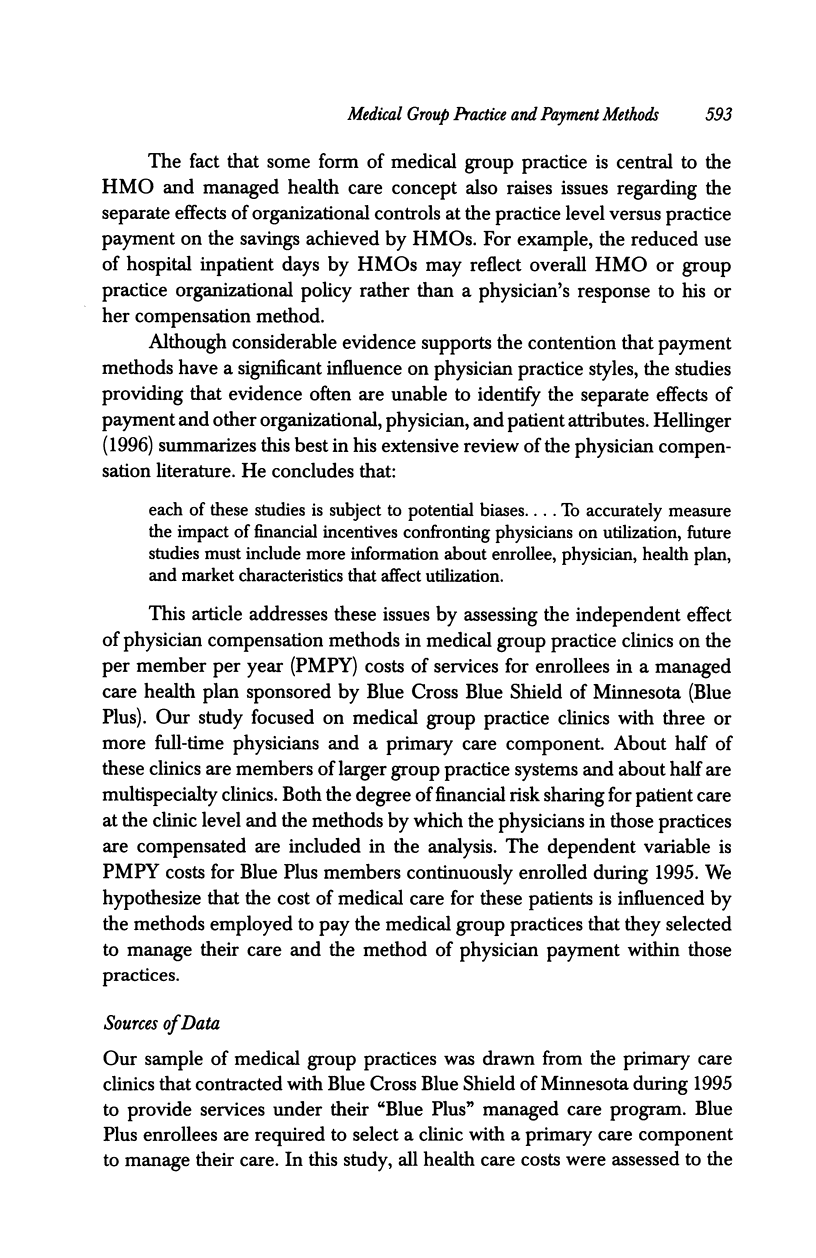
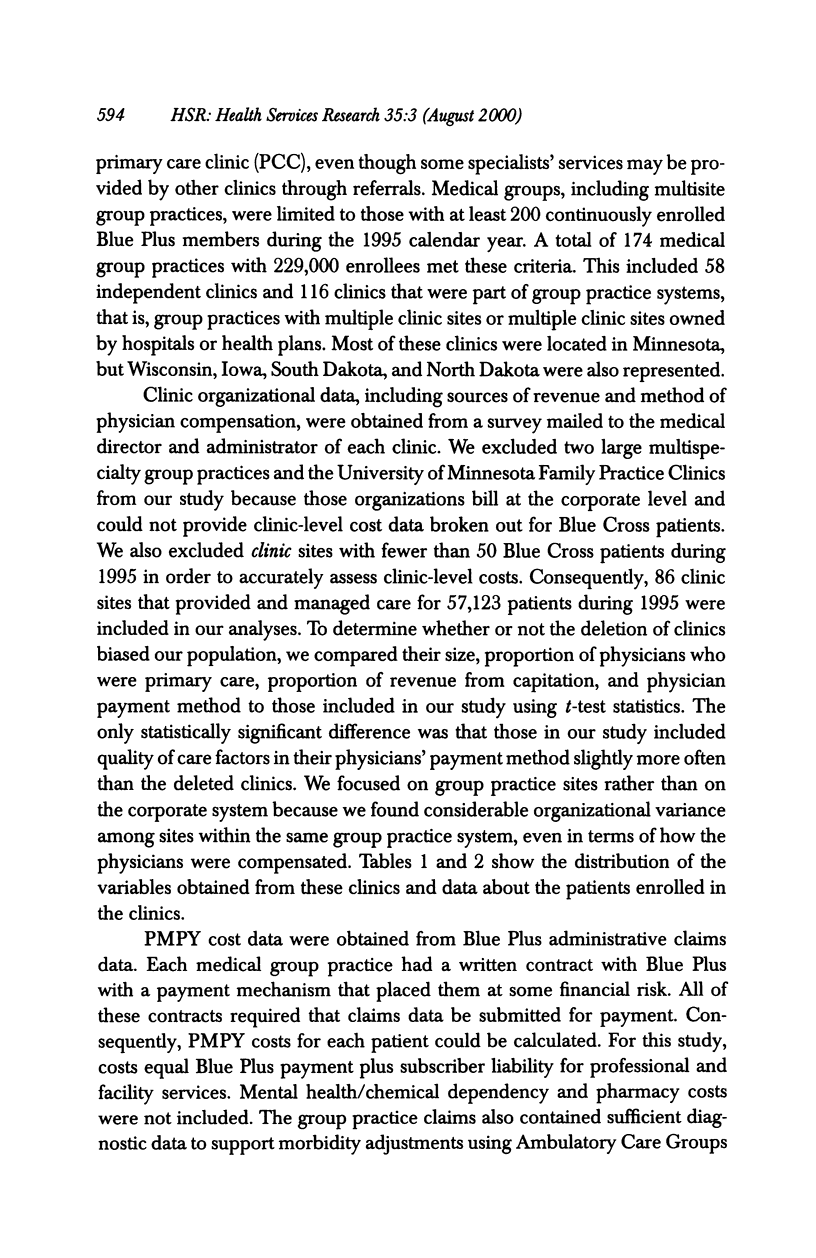
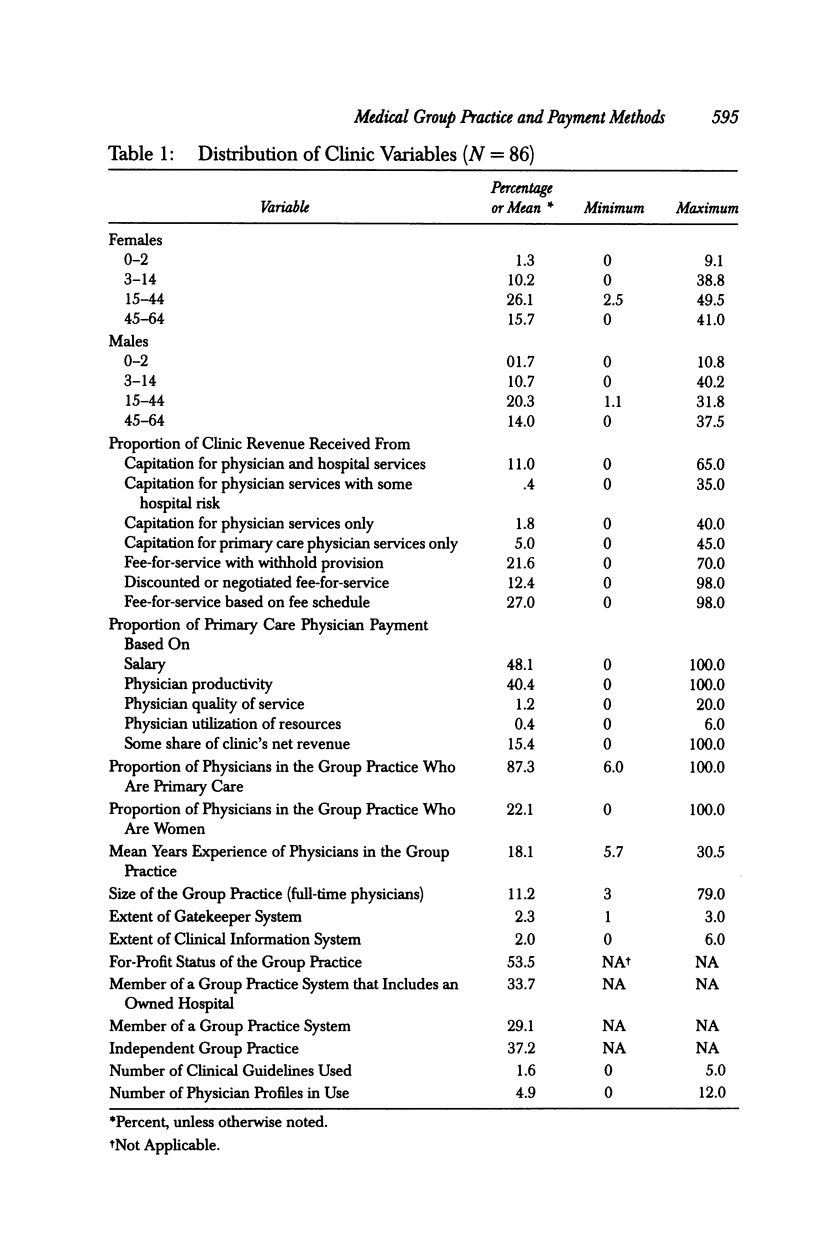
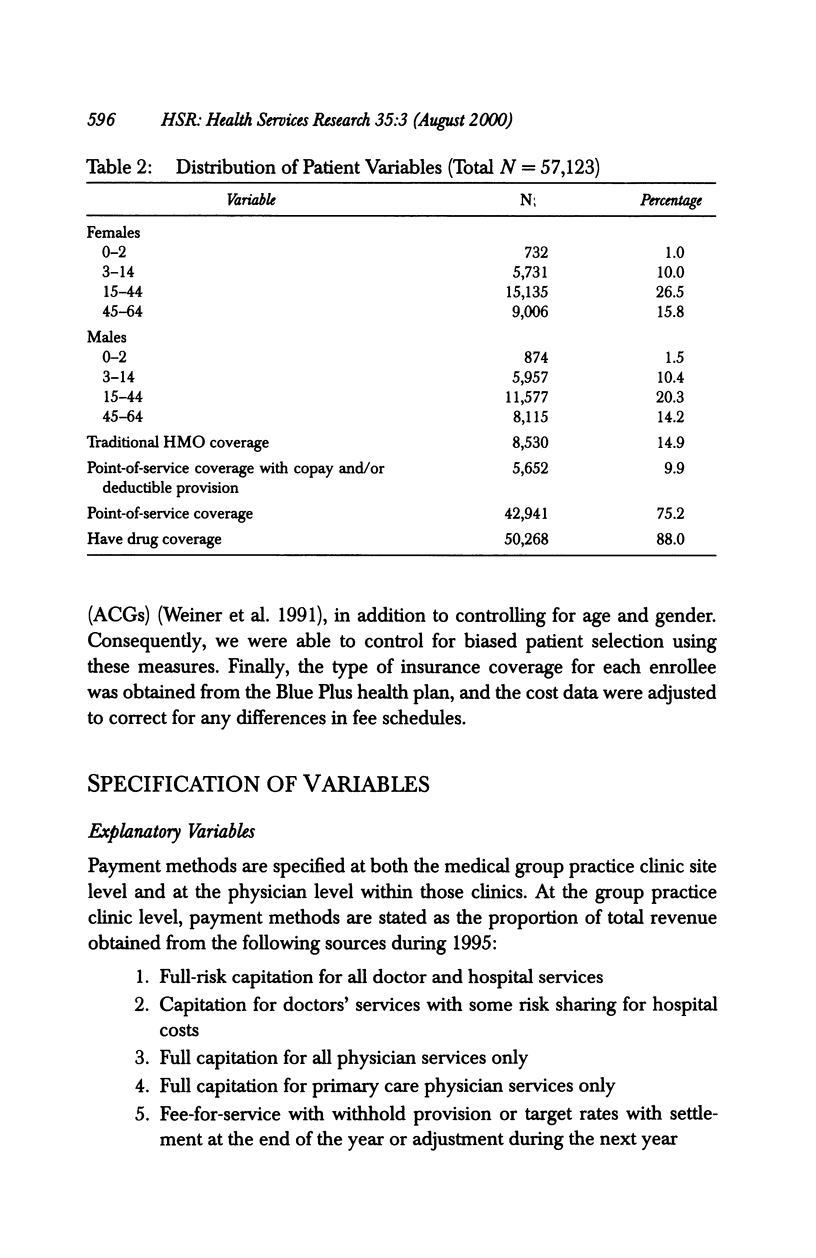
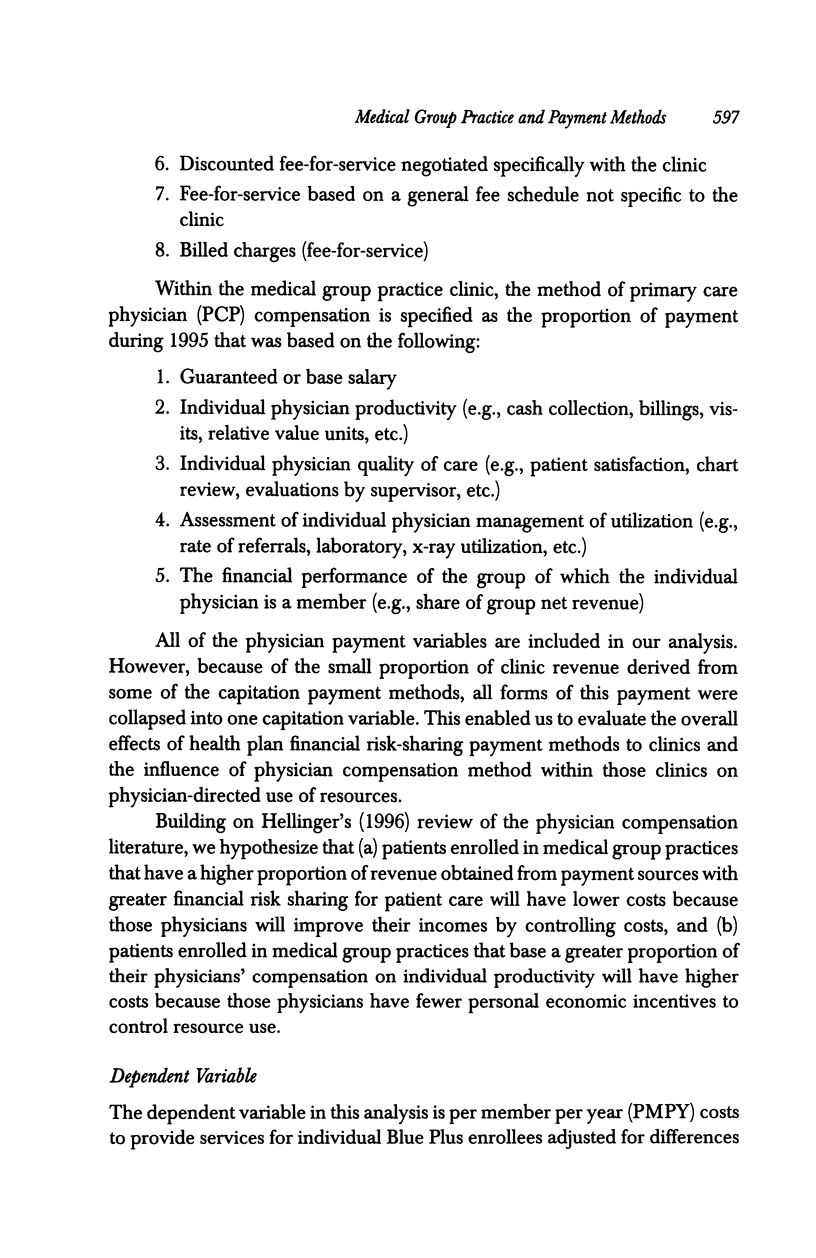
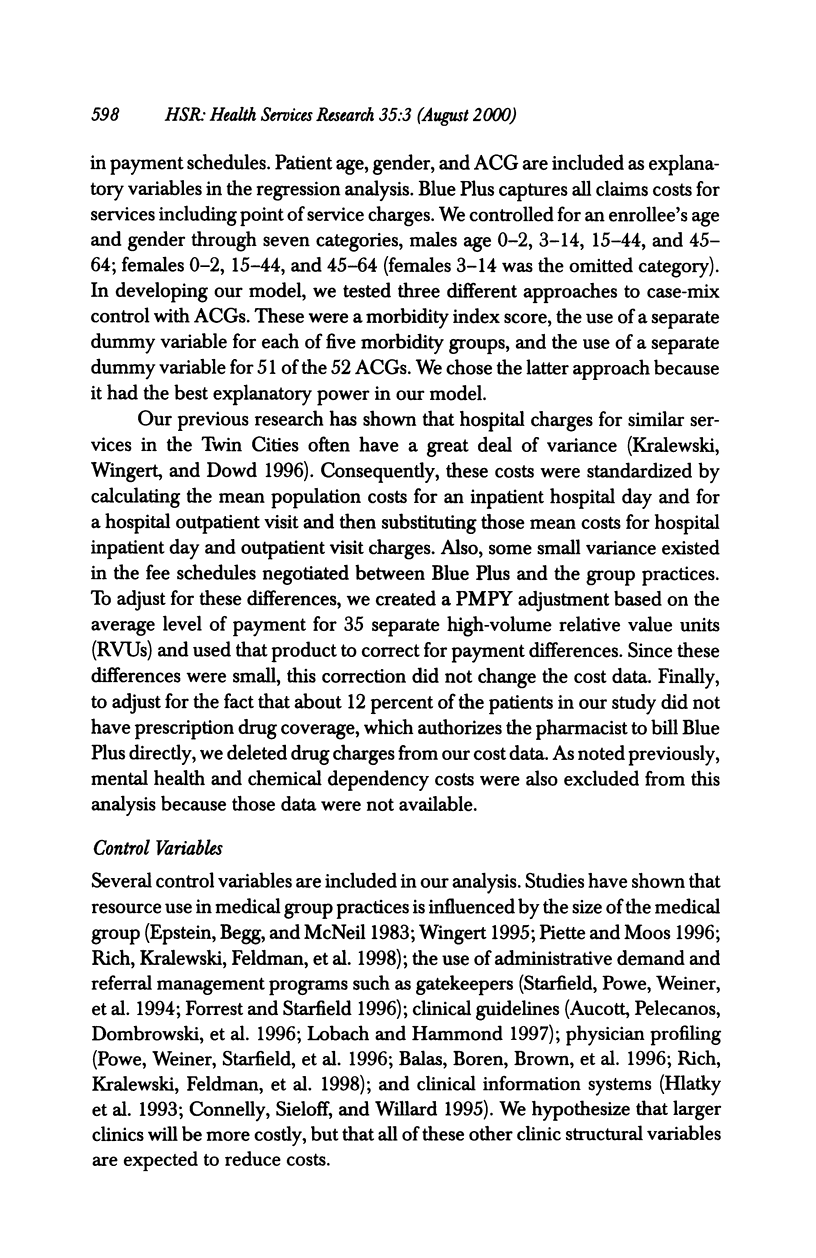
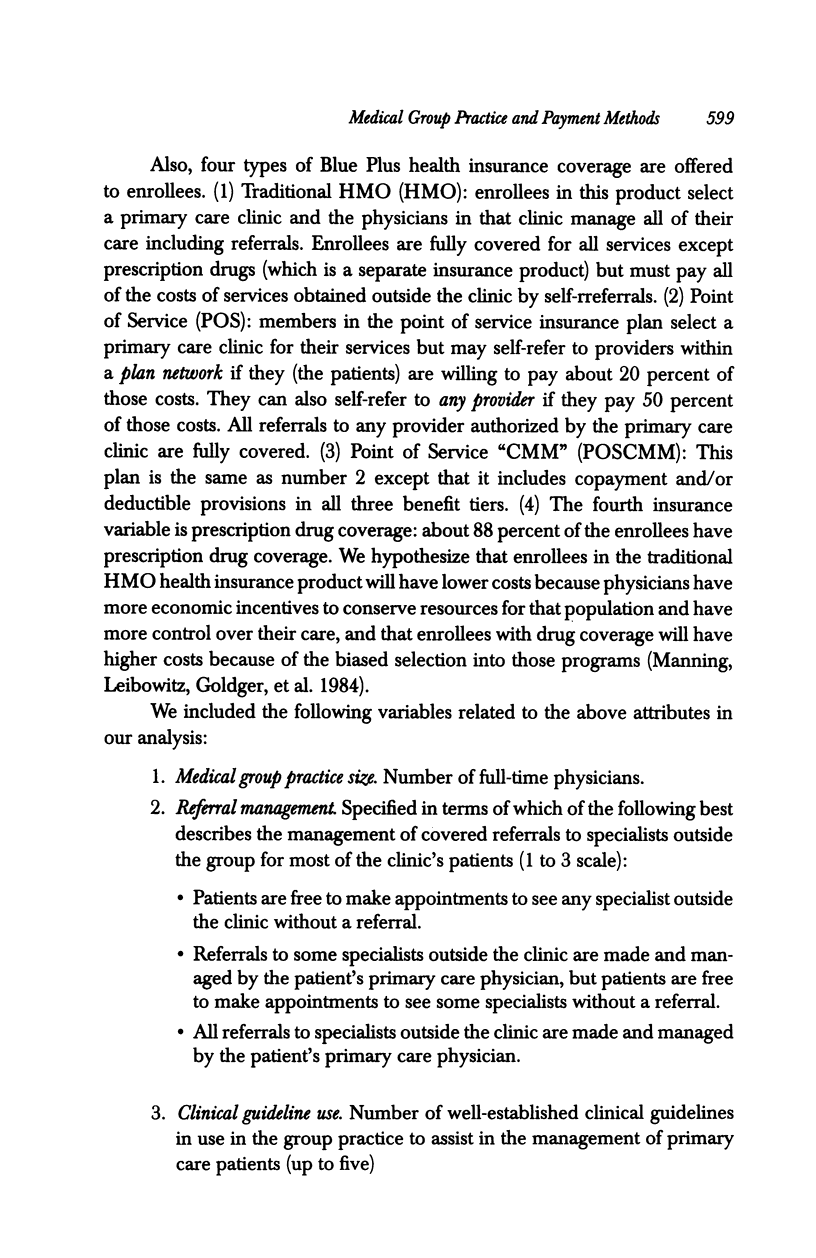
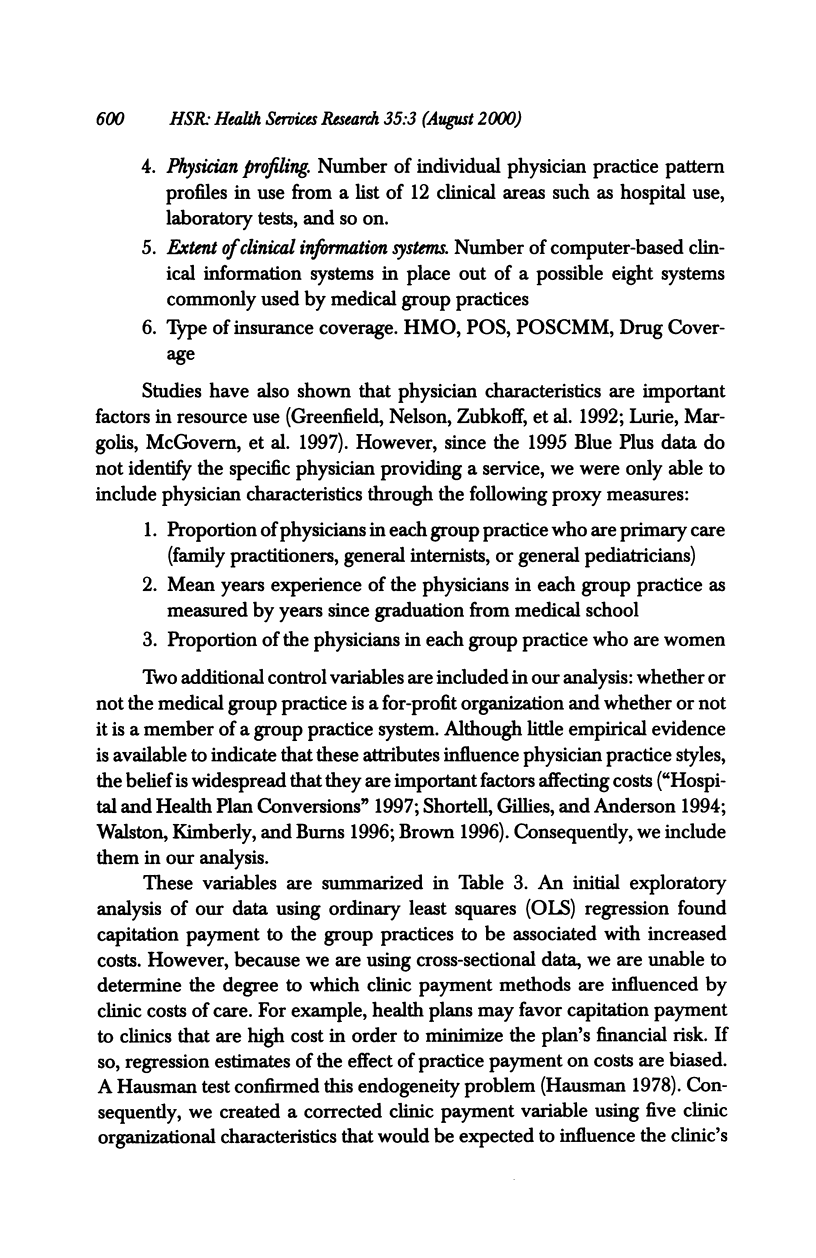
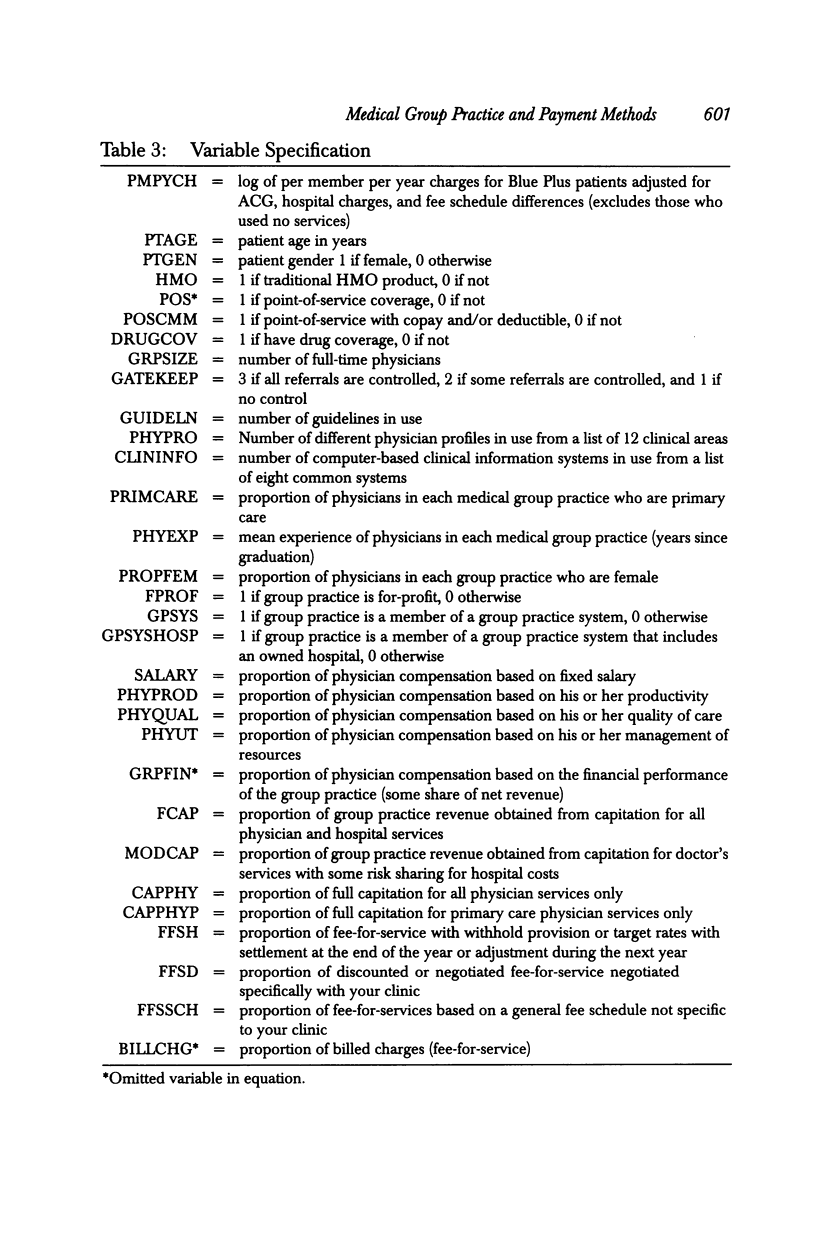
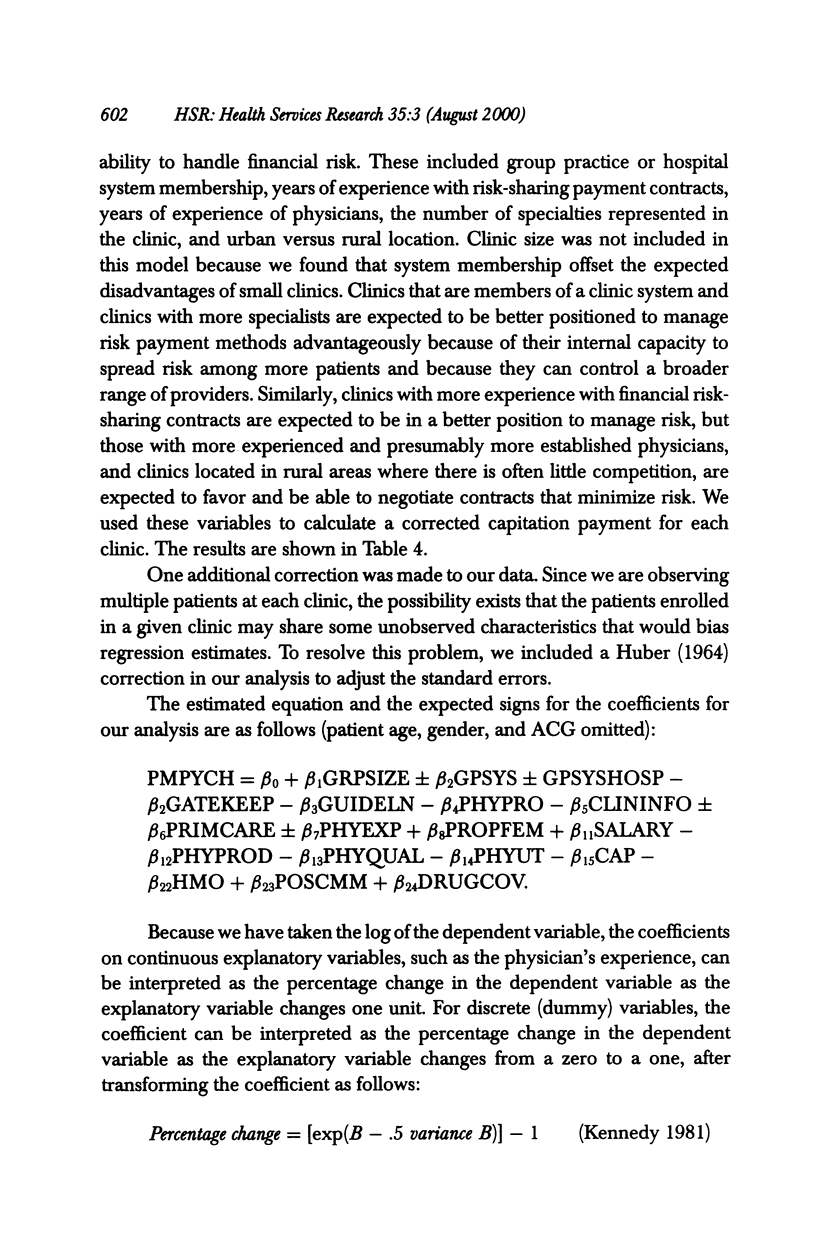
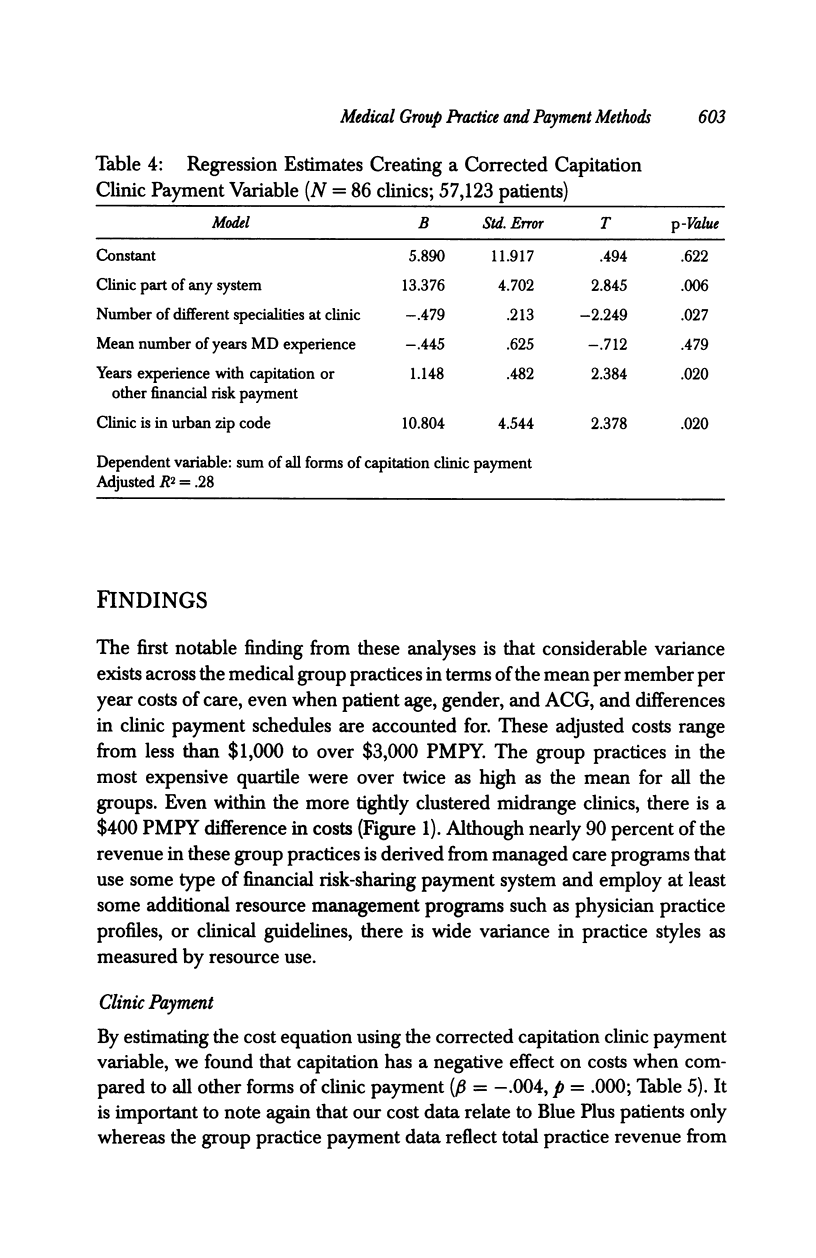
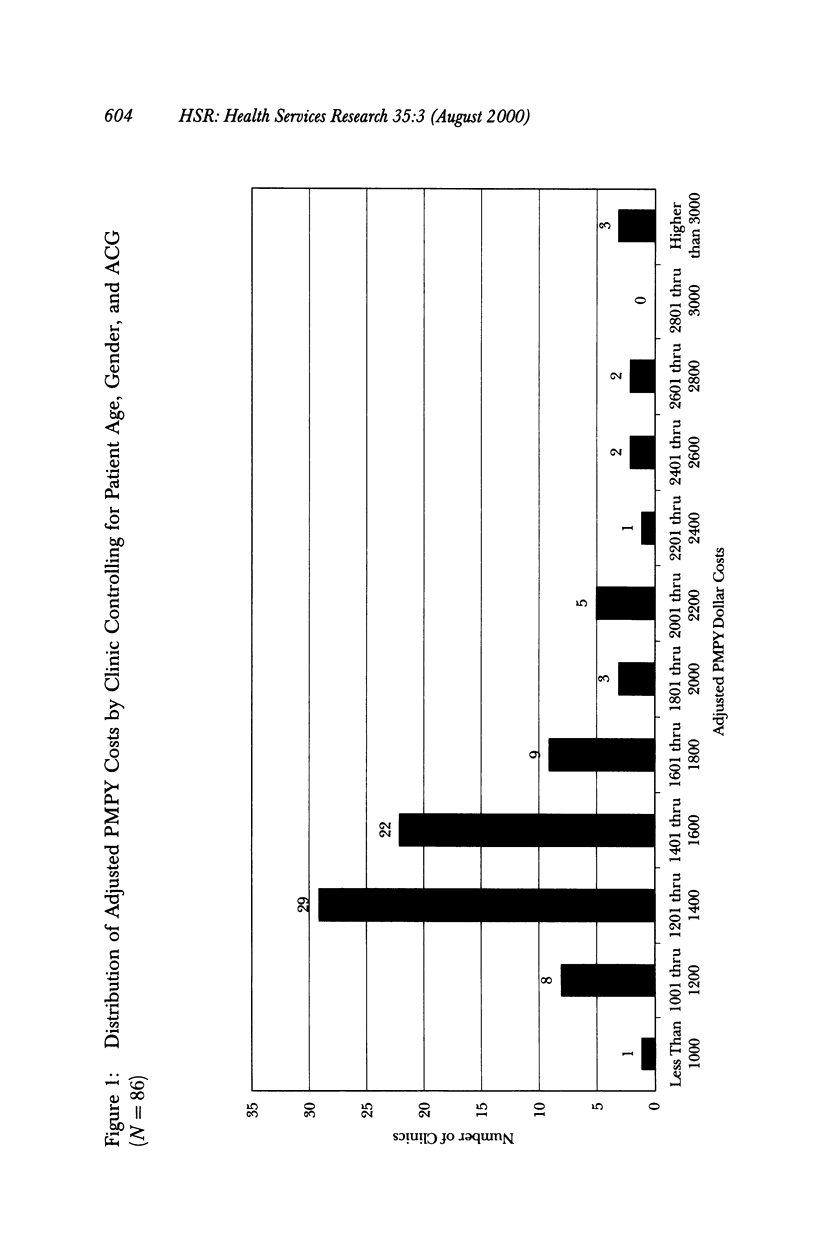
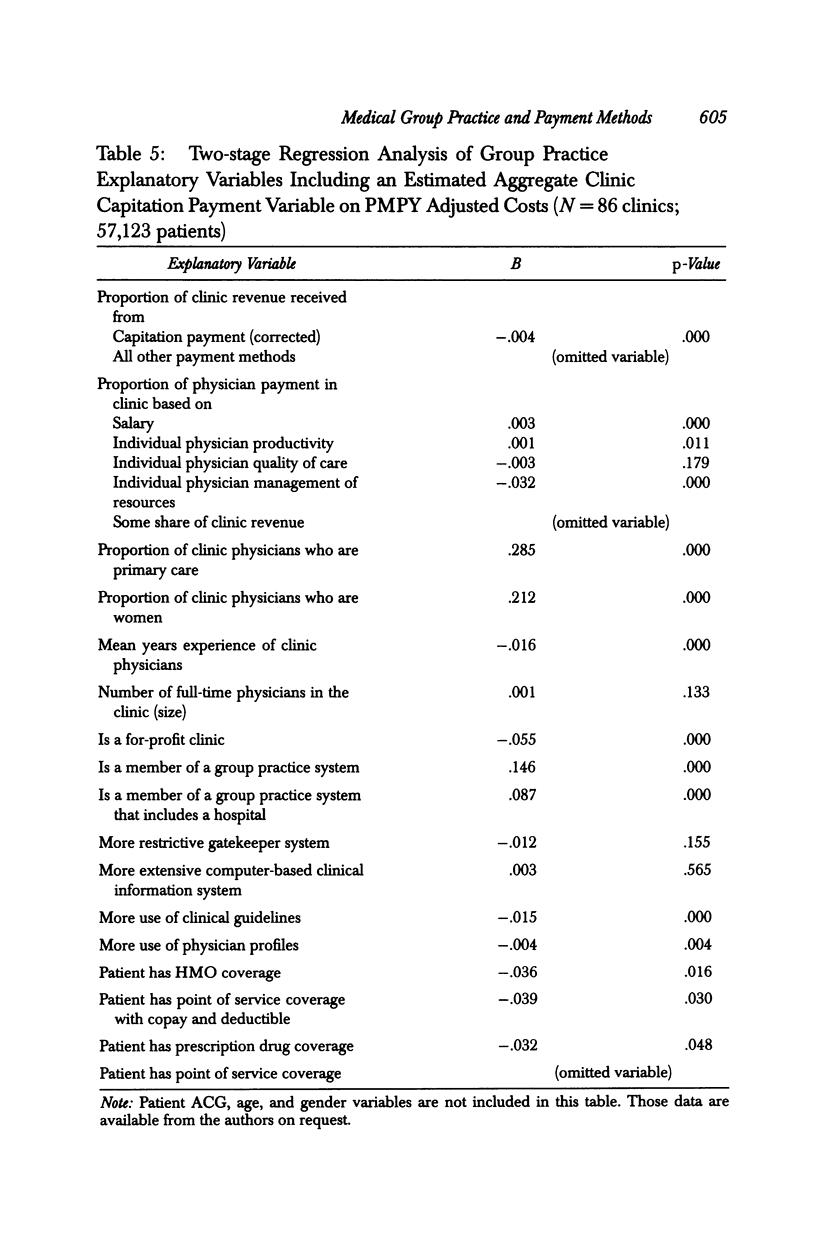
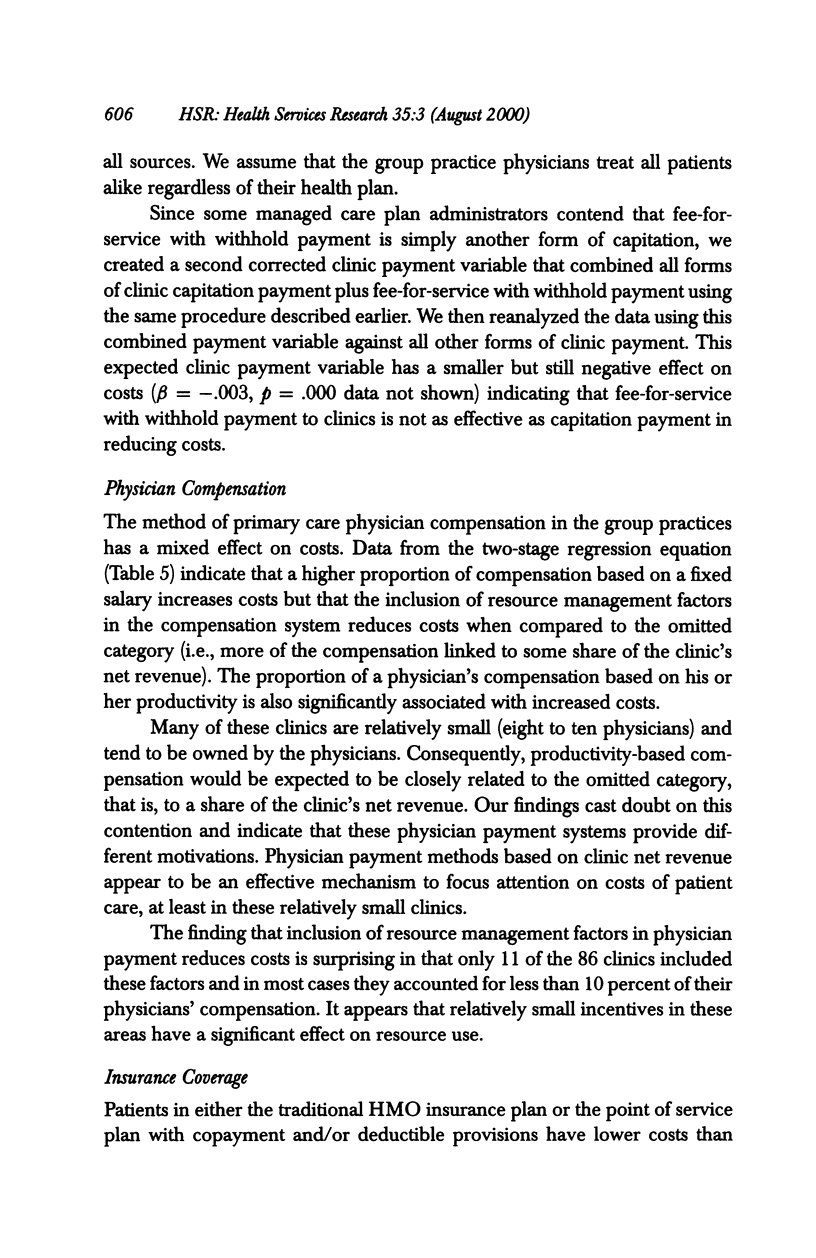
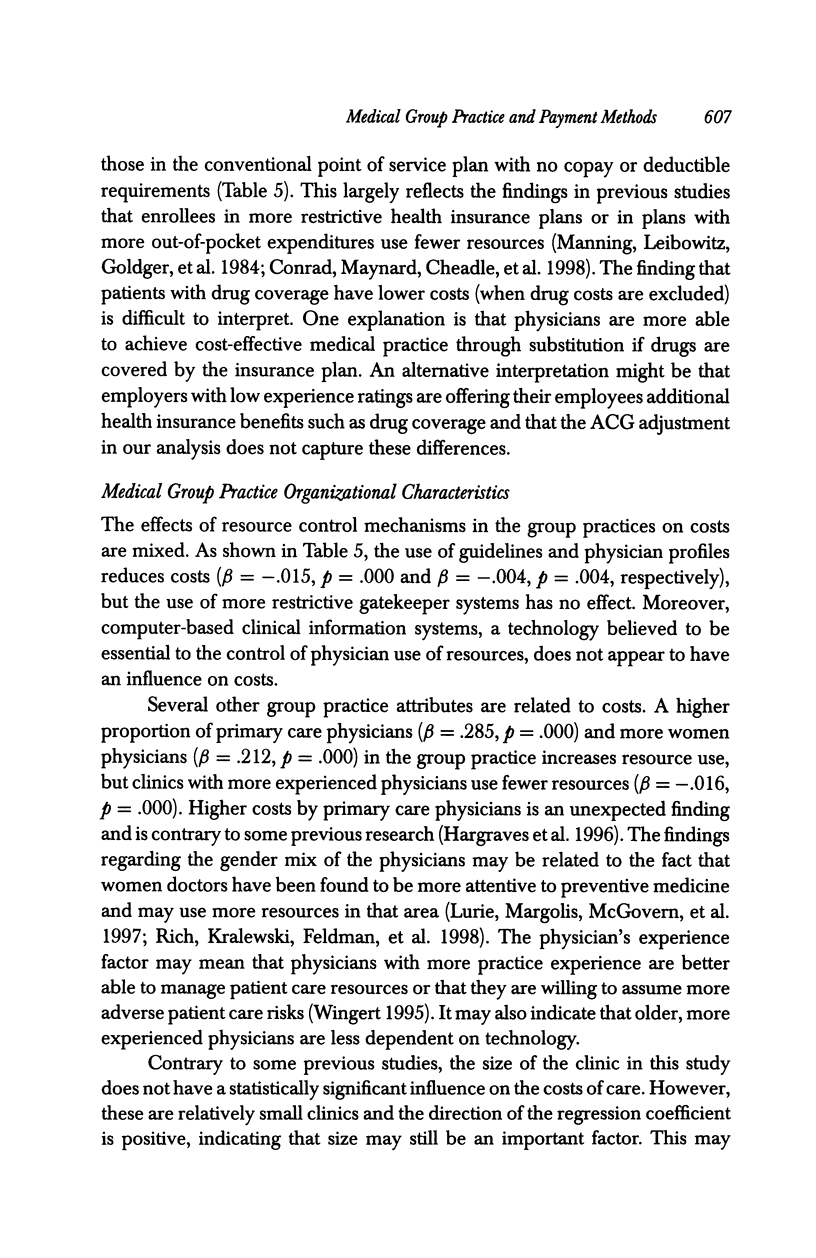
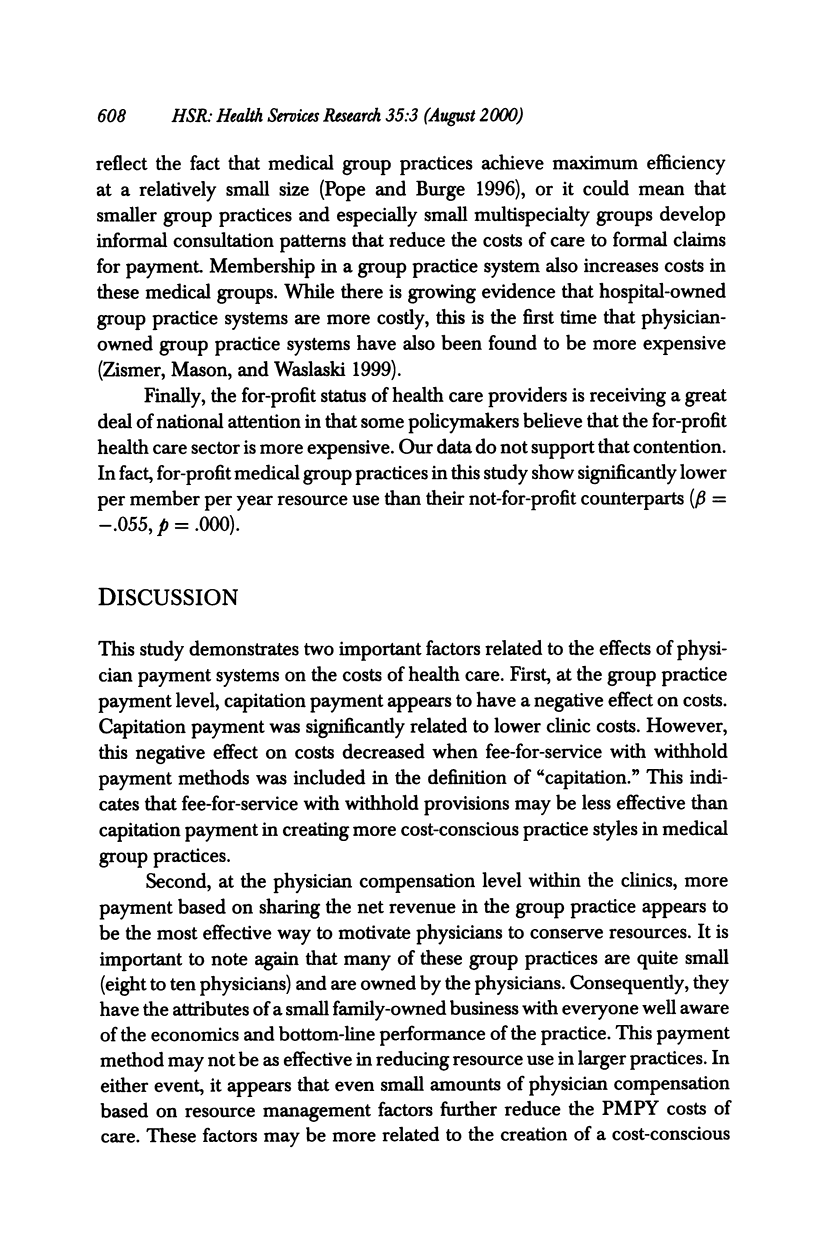
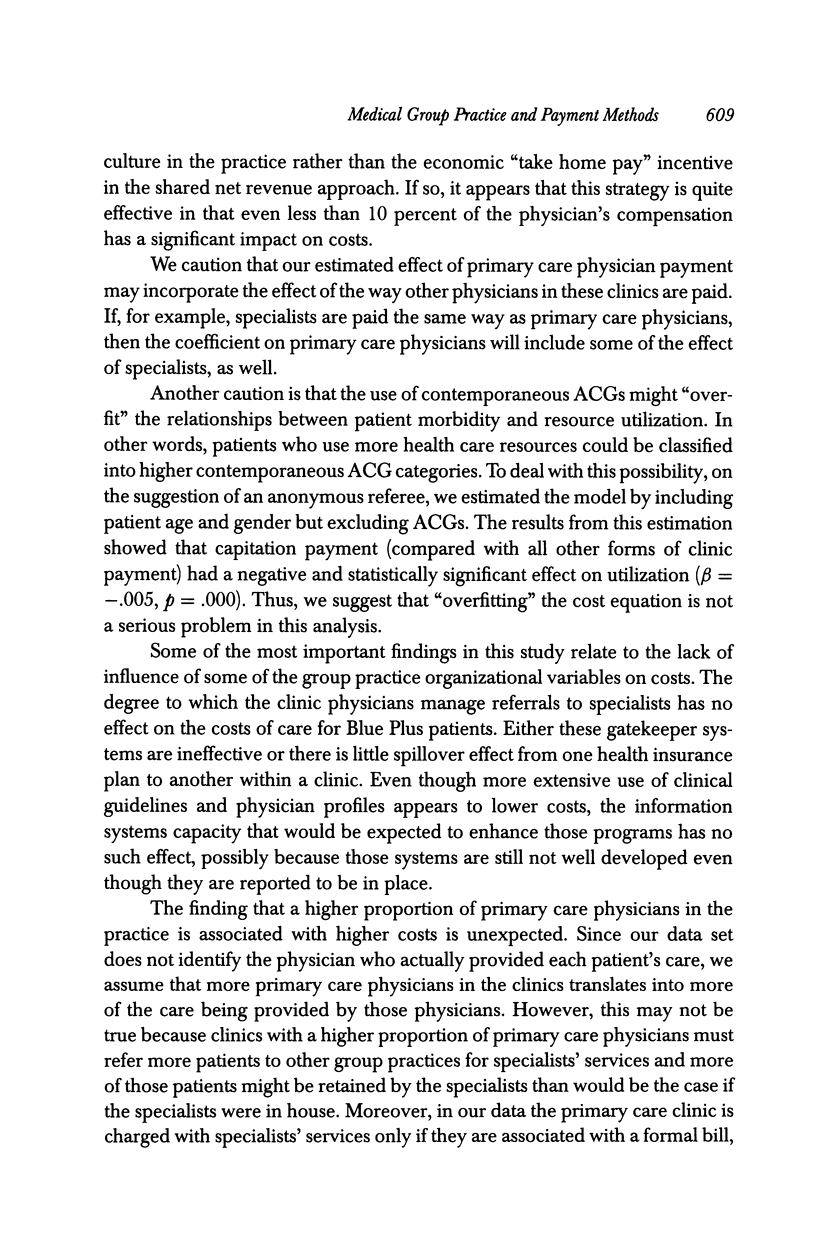
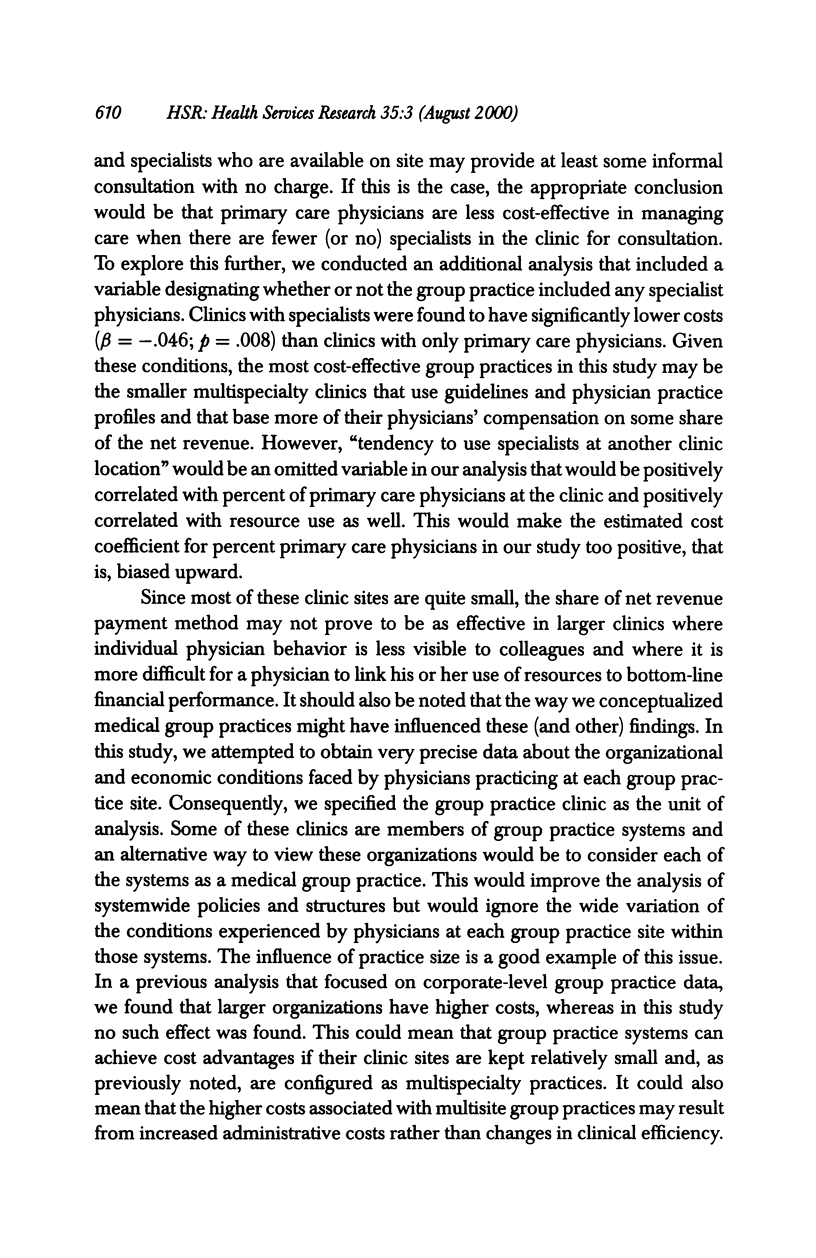
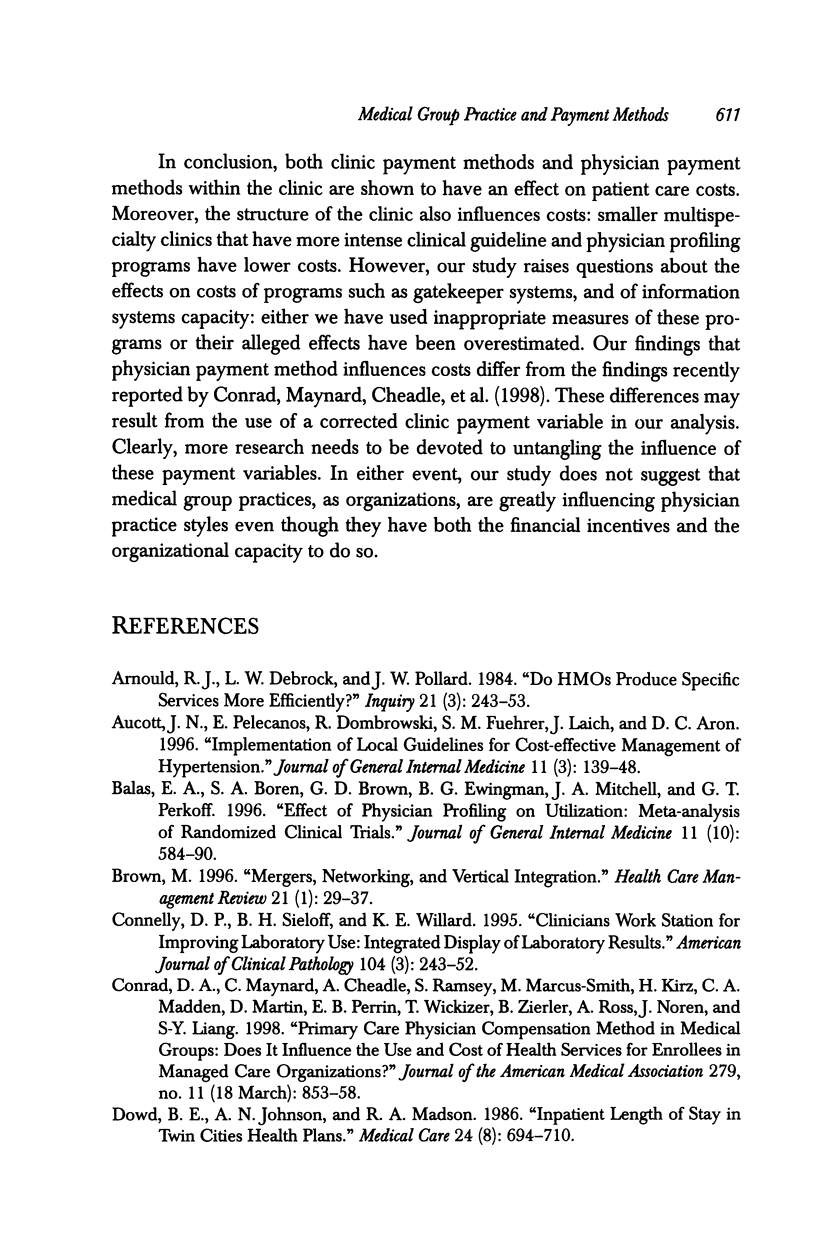
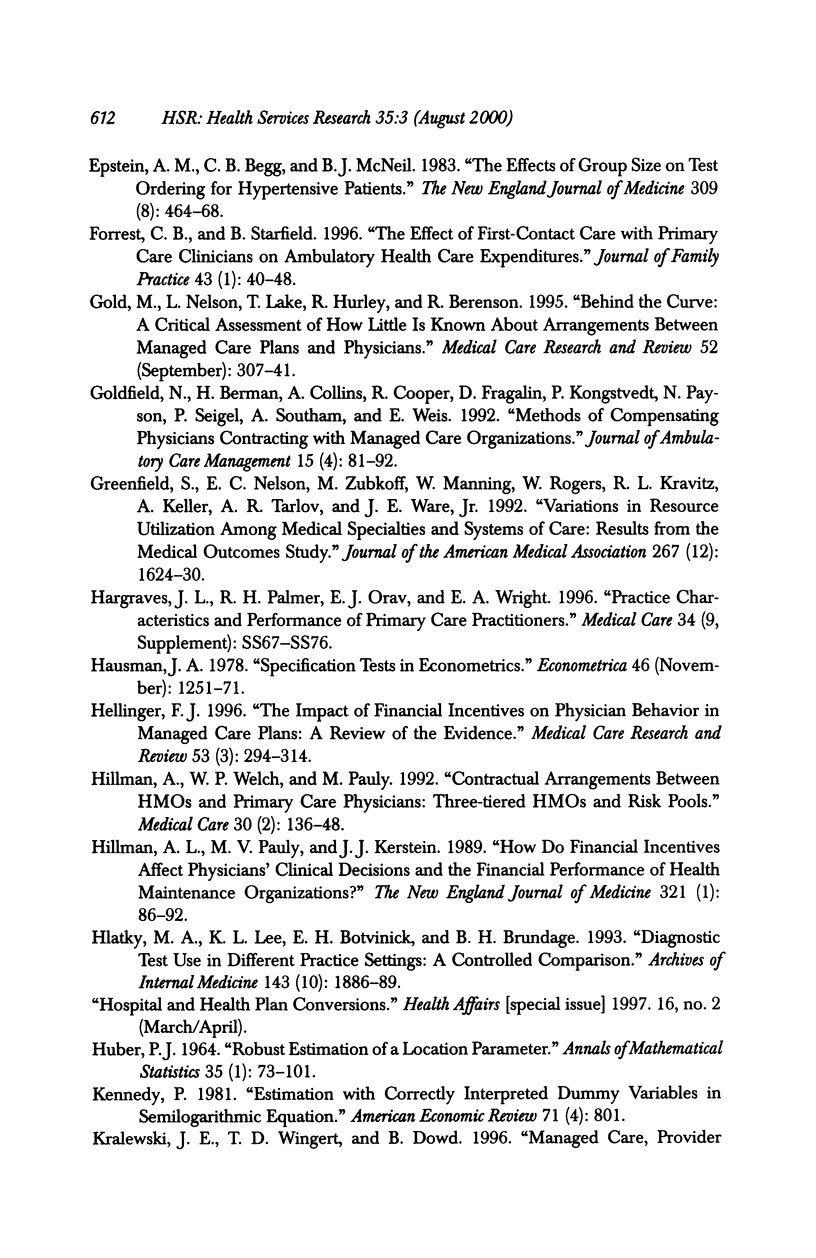
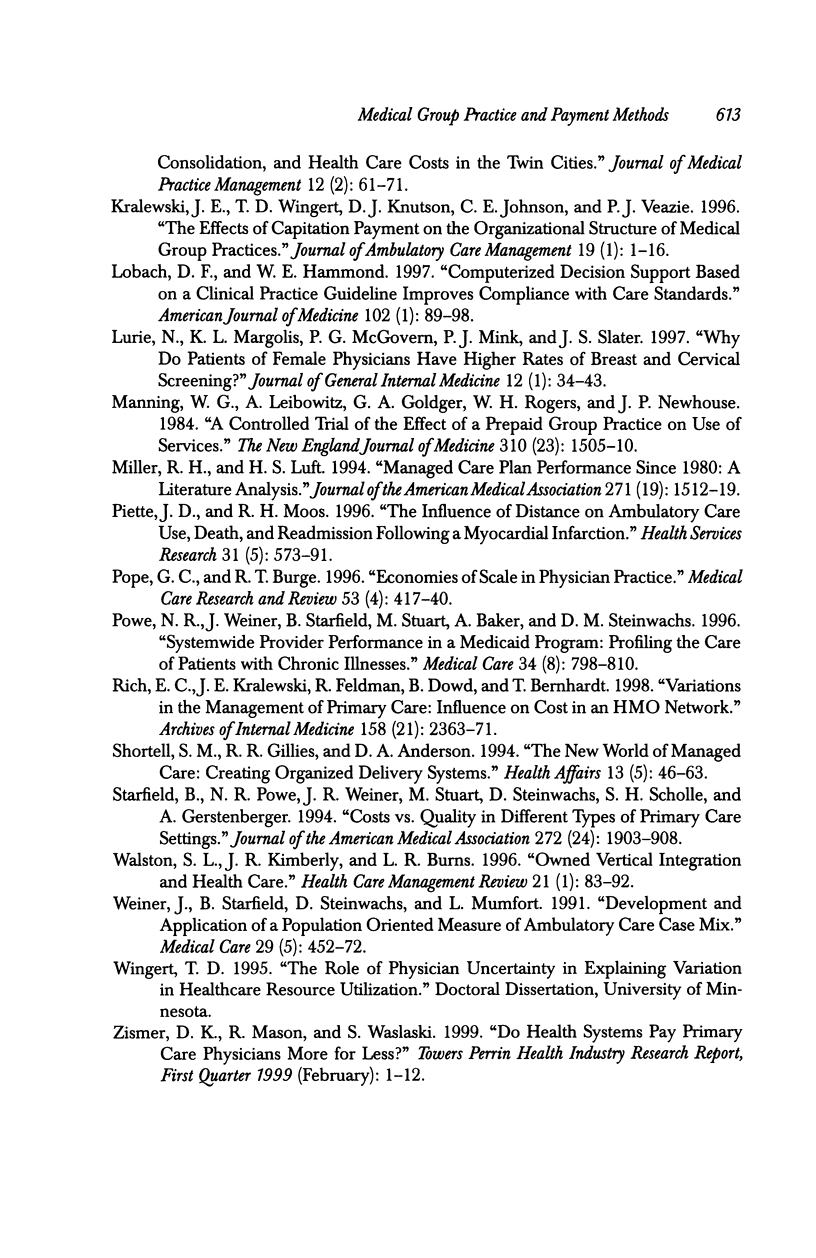
Selected References
These references are in PubMed. This may not be the complete list of references from this article.
- Arnould R. J., Debrock L. W., Pollard J. W. Do HMOs produce specific services more efficiently? Inquiry. 1984 Fall;21(3):243–253. [PubMed] [Google Scholar]
- Aucott J. N., Pelecanos E., Dombrowski R., Fuehrer S. M., Laich J., Aron D. C. Implementation of local guidelines for cost-effective management of hypertension. A trial of the firm system. J Gen Intern Med. 1996 Mar;11(3):139–146. doi: 10.1007/BF02600265. [DOI] [PubMed] [Google Scholar]
- Balas E. A., Boren S. A., Brown G. D., Ewigman B. G., Mitchell J. A., Perkoff G. T. Effect of physician profiling on utilization. Meta-analysis of randomized clinical trials. J Gen Intern Med. 1996 Oct;11(10):584–590. doi: 10.1007/BF02599025. [DOI] [PubMed] [Google Scholar]
- Brown M. Mergers, networking, and vertical integration: managed care and investor-owned hospitals. Health Care Manage Rev. 1996 Winter;21(1):29–37. [PubMed] [Google Scholar]
- Connelly D. P., Sielaff B. H., Willard K. E. A clinician's workstation for improving laboratory use. Integrated display of laboratory results. Am J Clin Pathol. 1995 Sep;104(3):243–252. doi: 10.1093/ajcp/104.3.243. [DOI] [PubMed] [Google Scholar]
- Conrad D. A., Maynard C., Cheadle A., Ramsey S., Marcus-Smith M., Kirz H., Madden C. A., Martin D., Perrin E. B., Wickizer T. Primary care physician compensation method in medical groups: does it influence the use and cost of health services for enrollees in managed care organizations? JAMA. 1998 Mar 18;279(11):853–858. doi: 10.1001/jama.279.11.853. [DOI] [PubMed] [Google Scholar]
- Dowd B. E., Johnson A. N., Madson R. A. Inpatient length of stay in Twin Cities health plans. Med Care. 1986 Aug;24(8):694–710. doi: 10.1097/00005650-198608000-00005. [DOI] [PubMed] [Google Scholar]
- Epstein A. M., Begg C. B., McNeil B. J. The effects of group size on test ordering for hypertensive patients. N Engl J Med. 1983 Aug 25;309(8):464–468. doi: 10.1056/NEJM198308253090805. [DOI] [PubMed] [Google Scholar]
- Forrest C. B., Starfield B. The effect of first-contact care with primary care clinicians on ambulatory health care expenditures. J Fam Pract. 1996 Jul;43(1):40–48. [PubMed] [Google Scholar]
- Gold M., Nelson L., Lake T., Hurley R., Berenson R. Behind the curve: a critical assessment of how little is known about arrangements between managed care plans and physicians. Med Care Res Rev. 1995 Sep;52(3):307–341. doi: 10.1177/107755879505200301. [DOI] [PubMed] [Google Scholar]
- Goldfield N. I., Berman H., Collins A., Cooper R., Dragalin D., Kongstvedt P., Payson N., Siegel D., Southam A., Weis E. Methods of compensating physicians contracting with managed care organizations. J Ambul Care Manage. 1992 Oct;15(4):81–92. doi: 10.1097/00004479-199210000-00012. [DOI] [PubMed] [Google Scholar]
- Greenfield S., Nelson E. C., Zubkoff M., Manning W., Rogers W., Kravitz R. L., Keller A., Tarlov A. R., Ware J. E., Jr Variations in resource utilization among medical specialties and systems of care. Results from the medical outcomes study. JAMA. 1992 Mar 25;267(12):1624–1630. [PubMed] [Google Scholar]
- Hargraves J. L., Palmer R. H., Orav E. J., Wright E. A. Practice characteristics and performance of primary care practitioners. Med Care. 1996 Sep;34(9 Suppl):SS67–SS76. doi: 10.1097/00005650-199609002-00007. [DOI] [PubMed] [Google Scholar]
- Hellinger F. J. The impact of financial incentives on physician behavior in managed care plans: a review of the evidence. Med Care Res Rev. 1996 Sep;53(3):294–314. doi: 10.1177/107755879605300305. [DOI] [PubMed] [Google Scholar]
- Hillman A. L., Pauly M. V., Kerstein J. J. How do financial incentives affect physicians' clinical decisions and the financial performance of health maintenance organizations? N Engl J Med. 1989 Jul 13;321(2):86–92. doi: 10.1056/NEJM198907133210205. [DOI] [PubMed] [Google Scholar]
- Hillman A. L., Welch W. P., Pauly M. V. Contractual arrangements between HMOs and primary care physicians: three-tiered HMOs and risk pools. Med Care. 1992 Feb;30(2):136–148. doi: 10.1097/00005650-199202000-00005. [DOI] [PubMed] [Google Scholar]
- Hlatky M. A., Lee K. L., Botvinick E. H., Brundage B. H. Diagnostic test use in different practice settings. A controlled comparison. Arch Intern Med. 1983 Oct;143(10):1886–1889. [PubMed] [Google Scholar]
- Kralewski J. E., Wingert T. D., Knutson D. J., Johnson C. E., Veazie P. J. The effects of capitation payment on the organizational structure of medical group practices. J Ambul Care Manage. 1996 Jan;19(1):1–16. doi: 10.1097/00004479-199601000-00002. [DOI] [PubMed] [Google Scholar]
- Lobach D. F., Hammond W. E. Computerized decision support based on a clinical practice guideline improves compliance with care standards. Am J Med. 1997 Jan;102(1):89–98. doi: 10.1016/s0002-9343(96)00382-8. [DOI] [PubMed] [Google Scholar]
- Lurie N., Margolis K. L., McGovern P. G., Mink P. J., Slater J. S. Why do patients of female physicians have higher rates of breast and cervical cancer screening? J Gen Intern Med. 1997 Jan;12(1):34–43. doi: 10.1046/j.1525-1497.1997.12102.x. [DOI] [PMC free article] [PubMed] [Google Scholar]
- Manning W. G., Leibowitz A., Goldberg G. A., Rogers W. H., Newhouse J. P. A controlled trial of the effect of a prepaid group practice on use of services. N Engl J Med. 1984 Jun 7;310(23):1505–1510. doi: 10.1056/NEJM198406073102305. [DOI] [PubMed] [Google Scholar]
- Miller R. H., Luft H. S. Managed care plan performance since 1980. A literature analysis. JAMA. 1994 May 18;271(19):1512–1519. [PubMed] [Google Scholar]
- Piette J. D., Moos R. H. The influence of distance on ambulatory care use, death, and readmission following a myocardial infarction. Health Serv Res. 1996 Dec;31(5):573–591. [PMC free article] [PubMed] [Google Scholar]
- Pope G. C., Burge R. T. Economies of scale in physician practice. Med Care Res Rev. 1996 Dec;53(4):417–440. doi: 10.1177/107755879605300403. [DOI] [PubMed] [Google Scholar]
- Powe N. R., Weiner J. P., Starfield B., Stuart M., Baker A., Steinwachs D. M. Systemwide provider performance in a Medicaid program. Profiling the care of patients with chronic illnesses. Med Care. 1996 Aug;34(8):798–810. doi: 10.1097/00005650-199608000-00007. [DOI] [PubMed] [Google Scholar]
- Rich E. C., Kralewski J., Feldman R., Dowd B., Bernhardt T. S. Variations in the management of primary care: effect on cost in an HMO network. Arch Intern Med. 1998 Nov 23;158(21):2363–2371. doi: 10.1001/archinte.158.21.2363. [DOI] [PubMed] [Google Scholar]
- Shortell S. M., Gillies R. R., Anderson D. A. The new world of managed care: creating organized delivery systems. Health Aff (Millwood) 1994 Winter;13(5):46–64. doi: 10.1377/hlthaff.13.5.46. [DOI] [PubMed] [Google Scholar]
- Starfield B., Powe N. R., Weiner J. R., Stuart M., Steinwachs D., Scholle S. H., Gerstenberger A. Costs vs quality in different types of primary care settings. JAMA. 1994 Dec 28;272(24):1903–1908. [PubMed] [Google Scholar]
- Walston S. L., Kimberly J. R., Burns L. R. Owned vertical integration and health care: promise and performance. Health Care Manage Rev. 1996 Winter;21(1):83–92. [PubMed] [Google Scholar]
- Weiner J. P., Starfield B. H., Steinwachs D. M., Mumford L. M. Development and application of a population-oriented measure of ambulatory care case-mix. Med Care. 1991 May;29(5):452–472. doi: 10.1097/00005650-199105000-00006. [DOI] [PubMed] [Google Scholar]


